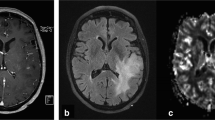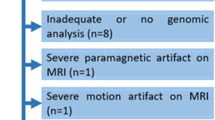Abstract
Objectives
Prediction of progression-free survival (PFS) and overall survival (OS) and early identification of molecular biomarkers with prognostic information are clinically important in glioblastoma (GBM) patients. We aimed to explore the utility of arterial spin labeling perfusion-weighted imaging (ASL-PWI) in the prediction of molecular biomarkers and survival in GBM patients.
Methods
We retrospectively analyzed 149 consecutive GBM patients, who had undergone maximal surgical resection or biopsy followed by concurrent chemoradiotherapy and adjuvant chemotherapy using temozolomide between November 2010 and June 2016. On preoperative ASL-PWI, cerebral blood flow (CBF) within contrast-enhancing (CE) and nonenhancing (NE) portions were evaluated both qualitatively (perfusion pattern[CE] and perfusion pattern[NE]) and quantitatively (nCBFCE and nCBFNE). ASL-PWI findings were correlated with molecular biomarkers, including isocitrate dehydrogenase (IDH) and O6-methylguanine-DNA methyltransferase (MGMT) methylation statuses, and survival, using the Mann-Whitney U-test, Spearman rank correlation, Kaplan-Meier analysis, and receiver operating characteristics analysis.
Results
nCBFCE was significantly higher in the IDH wild-type group than in the IDH mutant group (p = .013) and in the MGMT unmethylated group than in the methylated group (p = .047). Areas under the receiver operating characteristic curve were 0.678 for IDH mutation (p = .022) and 0.601 for MGMT promoter methylation (p = .043). Hyperperfusion was associated with the shortest median PFS for both perfusion pattern[CE] (7.6 months) and perfusion pattern[NE] (4.0 months). The perfusion pattern[NE] remained an independent predictor for PFS and OS even after adjusting for clinical and molecular predictors, unlike perfusion pattern[CE].
Conclusions
ASL-PWI can aid to predict survival and molecular biomarkers including IDH mutation and MGMT promoter methylation statuses in GBM patients.
Key Points
• ASL-PWI can aid to predict survival in GBM patients.
• ASL-PWI can aid to predict IDH and MGMT promoter methylation statuses in GBM.



Similar content being viewed by others
Abbreviations
- ASL:
-
Arterial spin labeling
- ATRX:
-
Alpha thalassemia/mental retardation syndrome x-linked gene
- CBF:
-
Cerebral blood flow
- CBV:
-
Cerebral blood volume
- CCRT:
-
Concurrent chemo- and radiation therapy
- DSC:
-
Dynamic susceptibility contrast-enhanced
- EGFR:
-
Epidermal growth factor receptor
- FLAIR:
-
Fluid-attenuated inversion recovery
- GBM:
-
Glioblastomas
- HIF-1α:
-
Hypoxia-inducible factor 1-alpha
- HR:
-
Hazard ratio
- IDH:
-
Isocitrate dehydrogenase
- IQR:
-
Interquartile range
- KPS:
-
Karnofsky performance score
- MGMT:
-
O6-methylguanine-DNA methyltransferase
- OS:
-
Overall survival
- PFS:
-
Progression-free survival
- PWI:
-
Perfusion-weighted imaging
- RANO:
-
Response assessment in neuro-oncology
- TMZ:
-
Temozolomide
- VEGF:
-
Vascular endothelial growth factor
References
Cancer Genome Atlas Research N (2008) Comprehensive genomic characterization defines human glioblastoma genes and core pathways. Nature 455:1061–1068
Frattini V, Trifonov V, Chan JM et al (2013) The integrated landscape of driver genomic alterations in glioblastoma. Nat Genet 45:1141–1149
Parsons DW, Jones S, Zhang X et al (2008) An integrated genomic analysis of human glioblastoma multiforme. Science 321:1807–1812
Verhaak RG, Hoadley KA, Purdom E et al (2010) Integrated genomic analysis identifies clinically relevant subtypes of glioblastoma characterized by abnormalities in PDGFRA, IDH1, EGFR, and NF1. Cancer Cell 17:98–110
Belden CJ, Valdes PA, Ran C et al (2011) Genetics of glioblastoma: a window into its imaging and histopathologic variability. Radiographics 31:1717–1740
Esteller M, Garcia-Foncillas J, Andion E et al (2000) Inactivation of the DNA-repair gene MGMT and the clinical response of gliomas to alkylating agents. N Engl J Med 343:1350–1354
Hegi ME, Diserens AC, Gorlia T et al (2005) MGMT gene silencing and benefit from temozolomide in glioblastoma. N Engl J Med 352:997–1003
Hong EK, Choi SH, Shin DJ et al (2018) Radiogenomics correlation between MR imaging features and major genetic profiles in glioblastoma. Eur Radiol. https://doi.org/10.1007/s00330-018-5400-8
Yamashita K, Hiwatashi A, Togao O et al (2016) MR imaging-based analysis of glioblastoma multiforme: estimation of IDH1 mutation status. AJNR Am J Neuroradiol 37:58–65
Heiland DH, Demerath T, Kellner E et al (2017) Molecular differences between cerebral blood volume and vessel size in glioblastoma multiforme. Oncotarget 8:11083–11093
Gupta A, Young RJ, Shah AD et al (2015) Pretreatment dynamic susceptibility contrast MRI perfusion in glioblastoma: prediction of EGFR gene amplification. Clin Neuroradiol 25:143–150
Ryoo I, Choi SH, Kim JH et al (2013) Cerebral blood volume calculated by dynamic susceptibility contrast-enhanced perfusion MR imaging: preliminary correlation study with glioblastoma genetic profiles. PLoS One 8:e71704
Qiao XJ, Ellingson BM, Kim HJ et al (2015) Arterial spin-labeling perfusion MRI stratifies progression-free survival and correlates with epidermal growth factor receptor status in glioblastoma. AJNR Am J Neuroradiol 36:672–677
Yoo RE, Choi SH, Cho HR et al (2013) Tumor blood flow from arterial spin labeling perfusion MRI: a key parameter in distinguishing high-grade gliomas from primary cerebral lymphomas, and in predicting genetic biomarkers in high-grade gliomas. J Magn Reson Imaging 38:852–860
Jain R, Poisson L, Narang J et al (2013) Genomic mapping and survival prediction in glioblastoma: molecular subclassification strengthened by hemodynamic imaging biomarkers. Radiology 267:212–220
Jain R, Poisson LM, Gutman D et al (2014) Outcome prediction in patients with glioblastoma by using imaging, clinical, and genomic biomarkers: focus on the nonenhancing component of the tumor. Radiology 272:484–493
Law M, Young RJ, Babb JS et al (2008) Gliomas: predicting time to progression or survival with cerebral blood volume measurements at dynamic susceptibility-weighted contrast-enhanced perfusion MR imaging. Radiology 247:490–498
Wen PY, Macdonald DR, Reardon DA et al (2010) Updated response assessment criteria for high-grade gliomas: response assessment in neuro-oncology working group. J Clin Oncol 28:1963–1972
Man MZ, Dyson G, Johnson K, Liao B (2004) Evaluating methods for classifying expression data. J Biopharm Stat 14:1065–1084
Ducray F, Marie Y, Sanson M (2009) IDH1 and IDH2 mutations in gliomas. N Engl J Med 360:2248–2249 author reply 2249
Ichimura K, Pearson DM, Kocialkowski S et al (2009) IDH1 mutations are present in the majority of common adult gliomas but rare in primary glioblastomas. Neuro Oncol 11:341–347
Myung JK, Cho HJ, Park CK, Kim SK, Phi JH, Park SH (2012) IDH1 mutation of gliomas with long-term survival analysis. Oncol Rep 28:1639–1644
Kickingereder P, Sahm F, Radbruch A et al (2015) IDH mutation status is associated with a distinct hypoxia/angiogenesis transcriptome signature which is non-invasively predictable with rCBV imaging in human glioma. Sci Rep 5:16238
Chahal M, Xu Y, Lesniak D et al (2010) MGMT modulates glioblastoma angiogenesis and response to the tyrosine kinase inhibitor sunitinib. Neuro Oncol 12:822–833
Burger PC, Heinz ER, Shibata T, Kleihues P (1988) Topographic anatomy and CT correlations in the untreated glioblastoma multiforme. J Neurosurg 68:698–704
Parsa AT, Wachhorst S, Lamborn KR et al (2005) Prognostic significance of intracranial dissemination of glioblastoma multiforme in adults. J Neurosurg 102:622–628
Oh J, Sahgal A, Sanghera P et al (2011) Glioblastoma: patterns of recurrence and efficacy of salvage treatments. Can J Neurol Sci 38:621–625
Wick W, Stupp R, Beule AC et al (2008) A novel tool to analyze MRI recurrence patterns in glioblastoma. Neuro Oncol 10:1019–1024
Warmuth C, Gunther M, Zimmer C (2003) Quantification of blood flow in brain tumors: comparison of arterial spin labeling and dynamic susceptibility-weighted contrast-enhanced MR imaging. Radiology 228:523–532
Detre JA, Leigh JS, Williams DS, Koretsky AP (1992) Perfusion imaging. Magn Reson Med 23:37–45
Williams DS, Detre JA, Leigh JS, Koretsky AP (1992) Magnetic resonance imaging of perfusion using spin inversion of arterial water. Proc Natl Acad Sci U S A 89:212–216
Funding
This study has received funding by grants from the Seoul National University Hospital Research Funds (04-2015-0690).
Author information
Authors and Affiliations
Corresponding author
Ethics declarations
Guarantor
The scientific guarantor of this publication is Tae Jin Yun.
Conflict of interest
The authors of this manuscript declare no relationships with any companies, whose products or services may be related to the subject matter of the article.
Statistics and biometry
One of the authors (R.E.Y.) has significant statistical expertise.
Informed consent
Requirement for informed consent was waived due to its retrospective nature.
Ethical approval
Institutional Review Board approval was obtained.
Study subjects or cohorts overlap
Part of the patient population in this study (n = 132) overlaps with those in a previous study (Hong EK, Choi SH, Shin DJ et al (2018) Radiogenomics correlation between MR imaging features and major genetic profiles in glioblastoma. Eur Radiol. https://doi.org/10.1007/s00330-018-5400-8). The current study differs from the previous study in that we used ASL-PWI to conduct rigorous radiogenomics and survival analyses, focusing on both enhancing and nonenhancing portions of tumors. Moreover, the current study expands on the prior study by having a larger patient number and includes a more in-depth survival analysis using a multivariable survival model based on various imaging, molecular, and clinical predictors.
Methodology
• retrospective
• diagnostic or prognostic study
• performed at one institution
Additional information
Publisher’s note
Springer Nature remains neutral with regard to jurisdictional claims in published maps and institutional affiliations.
Electronic supplementary material
ESM 1
(DOCX 2302 kb)
Rights and permissions
About this article
Cite this article
Yoo, RE., Yun, T.J., Hwang, I. et al. Arterial spin labeling perfusion-weighted imaging aids in prediction of molecular biomarkers and survival in glioblastomas. Eur Radiol 30, 1202–1211 (2020). https://doi.org/10.1007/s00330-019-06379-2
Received:
Revised:
Accepted:
Published:
Issue Date:
DOI: https://doi.org/10.1007/s00330-019-06379-2




